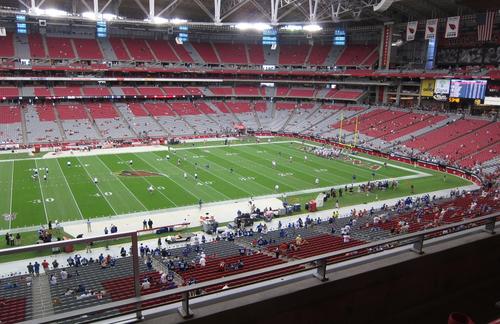2015 Super Bowl Shines Under Newly Installed LEDs
In preparation for hosting the 2015 Super Bowl, University of Phoenix Stadium in Glendale, AZ has recently installed high performance LED lights throughout its venue. The project occurred over two years and was completed in September of the 2014-2015 season. University of Phoenix Stadium is home to the Arizona Cardinals, in addition to hosting several large football games since the upgrade including: the Fiesta Bowl, the Pro Bowl, and this weekend the Super Bowl.
The project by the numbers:
- 780 metal halide fixtures were replaced with a mere 312 LED lights
- The new fixtures use 310,000 watts of energy vs. 1.24 million previously
- An approximate reduction of 75% in overall lighting energy consumption expected
(Data from Business Wire press release)
In addition to utility savings, the LED lights offer numerous benefits. LED lighting provides a brighter, more uniform light to the field, which eliminates shadows. It is easy to see how this would benefit the players and referees on the field, but it also makes for a better viewing experience for those watching the game at home. Players, broadcasters, and fans alike have given positive feedback on the upgraded lighting. Furthermore, because the new LED fixtures run cooler, the arena can expect to save on the reduced pressure placed on the facility's air conditioner.
Another huge advantage to using LED lighting in a huge arena is that there is no delay when turned on to allow for warm up. The previously used, metal halide fixtures can take as long as twenty minutes to warm up, precious time that the host of the Super Bowl cannot afford to waste on such a grand stage. Yet another benefit to the efficient lighting is that it allows for light shows to be put on, further enhancing the fan experience.

As previously blogged about, energy efficiency enhancements are the new trend in sporting arenas. While many other venues are making the switch to LED, this was the first stadium to have a playing field completely lit by LED lighting. With all of the technological advances being made in fan and player experience, retractable domes and expandable seating, to name a few, efficiency upgrades are a huge factor in venues like University of Phoenix Stadium winning bids for these global platform games. The competition between venues to host these huge games is rising the bar for what is considered stadium standard in energy initiative, which is a good thing for all involved.
Source: Business Wire





